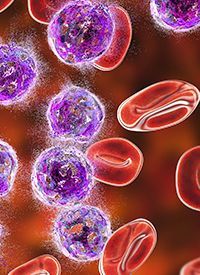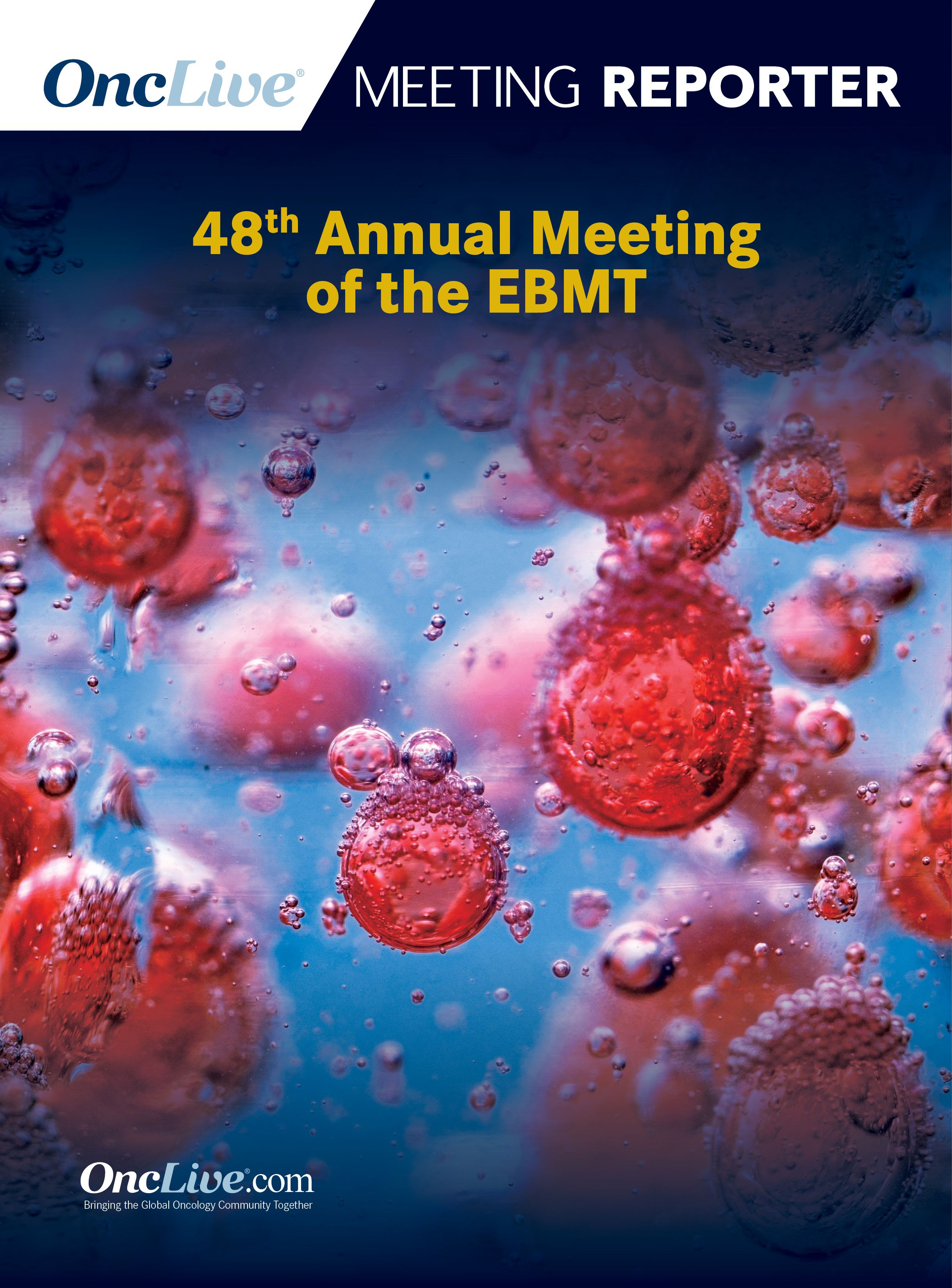Publication
Article
Treosulfan-Based Conditioning Improves Survival in Elderly, Comorbid Patients With AML
Author(s):
Treatment with a treosulfan-based conditioning regimen led to a superior event-free and overall survival compared with busulfan-based conditioning in patients with acute myeloid leukemia undergoing allogeneic hematopoietic cell transplantation, according to a post-hoc subgroup analysis of the phase 3 MC-FludT.14/L trial.

Treatment with a treosulfan-based conditioning regimen led to a superior event-free and overall survival (OS) compared with busulfan-based conditioning in patients with acute myeloid leukemia (AML) undergoing allogeneic hematopoietic cell transplantation (HCT), according to a post-hoc subgroup analysis of the phase 3 MC-FludT.14/L trial (NCT00822393) that were presented during the EBMT 48th Annual Meeting.1
The benefit was observed in elderly patients and in those with comorbidities.
Data showed that the 2-year event-free survival (EFS) rate was 64.7% (95% CI, 57.1%-71.3%) with treosulfan and 53.3% (95% CI, 45.2%-60.7%) with busulfan (HR, 0.64; 85% CI, 0.45-0.90; P = .012).
Additionally, the treosulfan-based regimen had a 2-year OS rate of 72.8% (95% CI, 65.5%-78.8%) compared with 64.7% with busulfan (95% CI, 56.7%-71.6%). Overall, the treosulfan-based conditioning regimen led to a 35% reduction in the risk of disease progression or death compared with busulfan (HR, 0.65; 95% CI, 0.43-0.96; P = .0303).
“This post-hoc subgroup analysis confirms the clinically relevant benefit of the treosulfan/fludarabine regimen as a relatively well-tolerated and effective preparative regimen for allogenic HCT in elderly and/or comorbid AML patients,” lead study author FriedrichStölzel, MD, of the University Hospital Carl Gustac Carus Dresden in Germany, said in a virtual presentation during the meeting.
Allogeneic HCT is a curative therapeutic option for patients with AML and myelodysplastic syndromes (MDS), and chemotherapy-based conditioning regimens are recommended for patients with myeloablative conditioning and reduced-intensity conditioning strategies. Currently, there are limited randomized data for this patient population who are older and have comorbidities.
Treosulfan combined with fludarabine has previously demonstrated tolerability in patients with AML and MDS in a dose-range finding trial as well as two phase 2 trials.2-4
In the AML cohort of the prospective, multicenter, phase 3 MC-FludT.14/L trial, investigators randomized 352 elderly and comorbid patients from 31 European transplant units in 5 countries to receive treosulfan intravenously (IV) at 3 x 10 g/m2 plus fludarabine at 5 x 30 mg/m2 (n = 184) or busulfan IV at 6.4 mg/kg plus fludarabine at 5 x 30 mg/m2 (n = 168). All patients were given cyclosporine plus methotrexate on days +1, +3, and +6.
To be eligible for enrollment, patients with AML in first or consecutive hematologic remission or MDS had to have a Haematopoietic Cell Transplantation Comorbidity Index (HCT-CI) greater than 2 and/or be at least 50 years old, a Karnofsky performance index of at least 60%, and a matched related or unrelated donor (≥910 human leukocyte antigens class I or II allele identities).
Stratification factors included cytogenetic/molecular risk group, donor type, and transplant center.
The primary end point was EFS within 2 years following allogeneic HSCT, and secondary outcome measures included engraftment, completion of donor-chimerism, OS, relapse/progression incidence, non-relapse mortality, acute and chronic graft-vs-host disease (GVHD), and safety. At the EBMT 48th Annual Meeting, data from the full analysis set of patients with AML were presented.
Regarding baseline characteristics for the patients with AML, more than half (56%) were male, the median age was 60 years (range, 31-70), and 95% of patients were aged at least 50 years. The median HCT-CI at baseline was 3; 59% of patients had HCT-CI greater than 2. Patients either had low- (11%), intermediate- (41%), or high-risk disease (35%), or not available (14%).
Results also showed that the complete donor chimerism rate at day +28 was 94% (95% CI, 90%-97%) with treosulfan and 87% (95% CI, 81%-92%) with busulfan. At day +100, these rates were 87% (95% CI, 81%-91%) and 83% (95% CI, 76%-88%), respectively. However, these results were not found to be statistically significant, Stölzel said.
Regarding cumulative index relapse and progression, the median was not available in either arm (HR, 0.82; 95% CI, 0.56-1.22; P value [a] = .3296; P value [b] = .5569). The 2-year cumulative index relapse/progression rates were 29.0% (95% CI, 21.9%-36.0%) with treosulfan and 26.9% (95% CI, 20.3%-33.5%) with busulfan. This was no significant difference between the 2 arms, he noted.
Cumulative index non-relapse mortality rates were also not available in either arm (HR, 0.62; 95% CI, 0.33-1.15; P value [a] = .1281; P value [b] = .1045) and the 2-year rates were 8.4% (95% CI, 4.3%-12.5%) with treosulfan and 14.7% (95% CI, 4.3%-12.5%).
There was no statistical difference in cumulative index chronic GVHD between the treosulfan and busulfan arms at a median 266 days and 371 days, respectively (HR, 1.16; 95% CI, 0.86-1.56; P = .3447). However, Stölzel said that extensive cumulative index GVHD, which was not available in either arm, was statistically significantly better with treosulfan (HR, 0.53; 95% CI, 0.31-0.88; P = .0128).
Additionally, the 2-year GVHD relapse-free survival rates were 52.9% with treosulfan and 39.6% with busulfan (HR, 0.69; 95% CI, 0.50-0.95; P = .0224).
References
- StölzelF, Stelljes M, Beelen D, et al. GVHD and GFRS in patients with AML undergoing allogeneic transplantation with treosulfan- versus busulfan-based conditioning: a subgroup analysis of the randomized pHASE III MC-FLUDT.14/L trial. Presented at: EBMT 48th Annual Meeting; March 19-23, 2022; virtual. Abstract OS16-06.
- Casper J, Wolff D, Knauf W, et al. Allogeneic hematopoietic stem-cell transplantation in patients with hematologic malignancies after dose-escalated treosulfan/fludarabine conditioning. J Clin Oncol. 2010;28(20):3344-3451. doi:10.1200/JCO.2009.23.3429.
- Ruutu T, Volin L, Beelen DW, et al. Reduced-toxicity conditioning with treosulfan and fludarabine in allogeneic hematopoietic stem cell transplantation for myelodysplastic syndromes: final results of an international prospective phase II trial. Haemaetologica. 2011;96(9):1344-1350. doi:10.3324/haematol.2011.043810.
- Casper J, Holowiecki J, Trenschel R, et al. Allogeneic hematopoietic SCT in patients with AML following treosulfan/fludarabine conditioning.Bone Marrow Transplant. 2012;47(9):1171-1177. doi:10.1038/bmt.2011.242.










